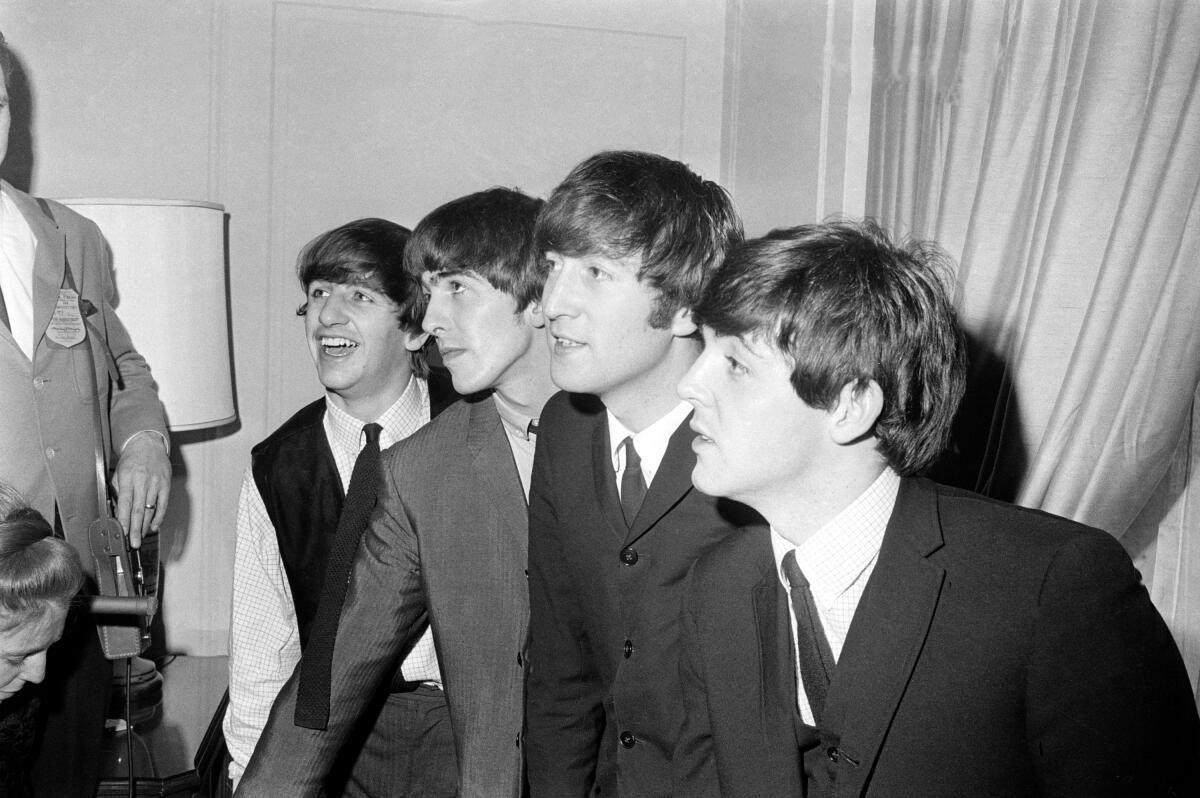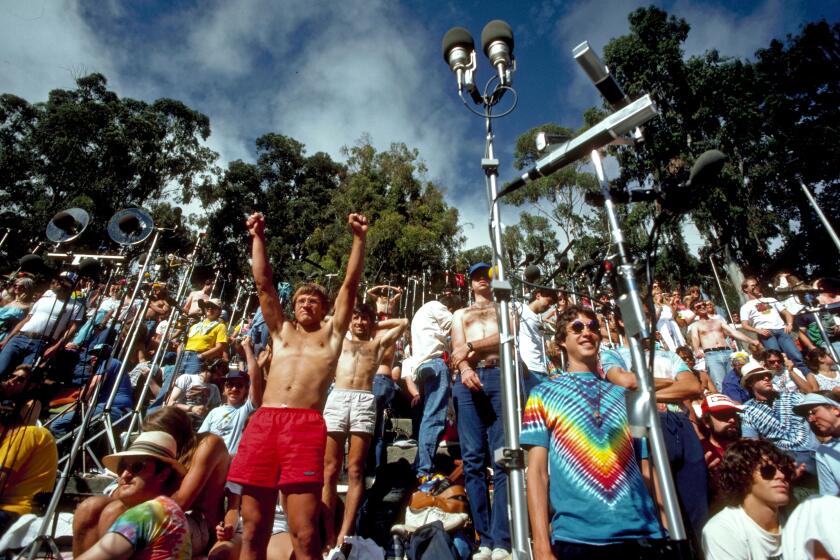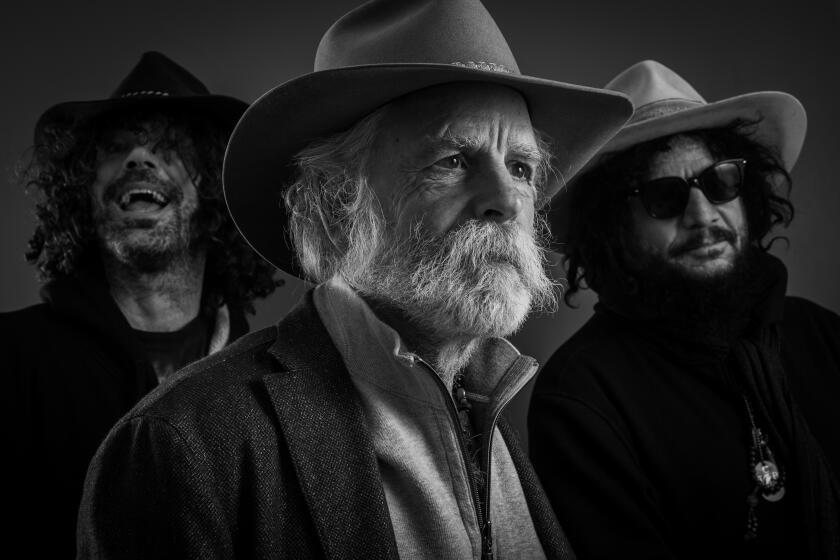Review: ‘The Number Ones’ examines backstories behind pop’s biggest hits

- Share via
On the Shelf
The Number Ones: Twenty Chart-Topping Hits That Reveal the History of Pop Music
By Tom Breihan
352 pages
$24.66
If you buy books linked on our site, The Times may earn a commission from Bookshop.org, whose fees support independent bookstores.
In February 1964, Paul McCartney boarded a plane for his first transatlantic trip to New York. Things definitely appeared to be on the upswing. He and his Beatles bandmates were booked to play the popular “Ed Sullivan Show” and two sets at famed Carnegie Hall. Less than a week earlier, “I Want to Hold Your Hand,” the exuberant sing-along that he had co-written with John Lennon, hit No. 1 on the Billboard Hot 100.
Still, the young McCartney worried. Capitol, the band’s American label, thought so little of the Beatles that it had refused to release any of their previous singles. Instead, Chicago label Vee-Jay put out “Please Please Me” and “From Me to You,” while Swan Records, a Philadelphia-based imprint co-founded by Dick Clark of TV’s “American Bandstand,” released “She Loves You.” Not one of the songs charted.
On that long-ago Pan Am flight to the Big Apple, McCartney sat next to Phil Spector, the architect of the Wall of Sound and future producer of “Let It Be.”
“Since America has always had everything, why should we be over there making money?” McCartney asked Spector. “They’ve got their own groups. What are we going to give them that they don’t already have?”
Nothing more than a musical and cultural revolution, according to Tom Breihan, author of the engaging, illuminating and exhilarating “The Number Ones: Twenty Chart-Topping Hits That Reveal the History of Pop Music.” The Beatles, Breihan notes, paved the way for the British Invasion, went on to have a record 20 No.1 singles and transformed popular music.
“In terms of pop-music impact, the Beatles’ arrival was a comet striking the earth,” Breihan writes. “If ‘I Want to Hold Your Hand’ merely announced the band’s American arrival, it would be one of the most important hit singles of all time. But ‘I Want to Hold Your Hand’ did more than that. It opened the floodgates.”
In “The Number Ones,” Breihan brings a laser-like focus and fan’s sensibility to stone-cold classic No. 1 hits such as The Supremes’ “Where Did Our Love Go” and Prince’s “When Doves Cry” as well as to fluff like Britney Spears’ “…Baby One More Time” and BTS’ 2020 K-pop smash “Dynamite.” Breihan selects six No. 1s from the 1960s, four from the 1980s, four from the 1990s and four from the 2000s. Curiously, he features only two songs from the seminal music of the 1970s, including the forgettable 1974 hit “Rock Your Baby” by George McCrae, “the first disco hitmaker,” in Breihan’s words.
Breihan concedes that his choices aren’t necessarily the best Hot 100 chart-toppers of all time. Instead, they “marked new moments in pop-music evolution— the ones that immediately made the previous weeks’ hits sound like relics.”
That’s debatable. In fact, one of the great joys of “The Number Ones” is second-guessing the author.

Was 1990’s “Ice Ice Baby” really the first rap song to top the charts? What about Blondie’s “Rapture,” which reached #1 nine years earlier and features an extended rap and even references hip-hop pioneer Fab 5 Freddy? Where’s “Satisfaction,” the Rolling Stones’ iconic 1965 chart-topper that launched a thousand garage bands and inspired raunchy, blues-based rock for decades to come? What about landmark No. 1s by Stevie Wonder, U2, Drake, Beyoncé and other defining artists?
Perhaps nobody writing about music today is better equipped to grapple with those questions than Breihan. A senior editor at the music news site Stereogum, he has spent the past five years writing about every No. 1 in the history of the Billboard Hot 100, beginning with Ricky Nelson’s “Poor Little Fool” in 1958. So far, he has made it to 2005.
Whether in his column or “The Number Ones,” Breihan unearths fascinating nuggets about even the most pedestrian songs. Like a Russian nesting doll, his writings contain multitudes.
Take “Ice Ice Baby,” the ridiculously catchy trifle that rode a hook from Queen and David Bowie’s “Under Pressure” to the top of the charts. As Breihan recounts, Suge Knight, a former NFL prospect and future convicted felon, threatened to throw Vanilla Ice off his hotel balcony unless he agreed to sign over some of the royalties from the smash hit. Mario “Chocolate” Johnson, a Dallas rapper and one of Knight’s clients, claimed he had written “Ice Ice Baby” and other Ice songs but never got paid.
A terrified Vanilla Ice quickly acceded to Knight’s demands. The entrepreneurial Knight leveraged his financial windfall to co-found Death Row Records, launch Dr. Dre’s solo career with the blockbuster “The Chronic” and make superstars of Snoop Dogg and 2Pac. In essence, Vanilla Ice’s success helped lay the groundwork for the gangsta rap that killed his career.

Through T-Pain’s “Buy U a Drank (Shawty Snappin’),” which hit No. 1 for one week in May 2007, Breihan chronicles the development of the voice-warping Auto-Tune technology that the artist took to the extreme and popularized. Then the backlash began, with Usher allegedly telling T-Pain that he had ruined music. Other musicians groused that Auto-Tune diminished the importance of real singing. Although rappers to this day continue to top the charts by emulating T-Pain’s Auto-Tune style, the man himself has at times moved in a different direction. In 2014, he showed off his stunning vocal chops by appearing without filters on NPR’s “Tiny Desk Concert” video. Five years later, T-Pain won the first season of Fox’s “The Masked Singer” TV show. Fascinating stuff.
That doesn’t mean that Breihan always strikes the right chord. In his zeal to cover as much ground as possible, he sometimes sacrifices nuance to overgeneralization. In a chapter about “Good Vibrations” by the Beach Boys, for instance, Breihan rightly notes that the group largely stopped producing massive hits after its 1966 psychedelia- tinged No. 1. However, the Beach Boys most certainly did not “lose their relevance as a pop act.” In the early 1970s, they did some of their strongest work, including 1970’s “Sunflower,” which critics rightfully hailed as a creative rebirth. Similarly, the Human League didn’t suddenly fade away and find themselves relegated to the oldies circuit after their ’80s commercial heyday. The synth-pop group, whose MTV-fueled “Don’t You Want Me” topped the charts in 1982, reached the Billboard Top 40 with “Tell Me When” 13 years later in 1995.
These are minor quibbles. With “The Number Ones,” Breihan has penned a work that resembles some of the indelible hits he spotlights: memorable, timeless and worth revisiting again and again.
Marc Ballon, a former L.A. Times reporter, teaches an advanced writing class at USC. He lives in Fullerton.
- Share via
Watch L.A. Times Today at 7 p.m. on Spectrum News 1 on Channel 1 or live stream on the Spectrum News App. Palos Verdes Peninsula and Orange County viewers can watch on Cox Systems on channel 99.
More to Read
Sign up for our Book Club newsletter
Get the latest news, events and more from the Los Angeles Times Book Club, and help us get L.A. reading and talking.
You may occasionally receive promotional content from the Los Angeles Times.













